8 Ways to Make Shipping Automation More Efficient
Time is money for business owners and entrepreneurs—spending it wisely saves money. For e-commerce merchants, growing your business can transform simple tasks into a daunting time suck. Without Shipping automation, there can be such thing as too much of a good thing. Increase in order volume and demand can quickly overwhelm a growing small business—leading to unhappy customers and a damaged reputation.
Automation allows you to clear the hurdles of growth and do more with less. Make repetitive tasks the work of hardware and software, not your workers. That frees your people to scale your business focus on more pressing matters rather than medial tasks.
It also gets products to customers quicker. How quickly a customer gets a product influences where up to 80% of online shoppers make their purchase.
1. Inventory management
You may know how much inventory you have on hand by looking at what’s stored in your garage, but do you know exactly how much? What if you’re using a 3PL? Take the guesswork out by being informed about exactly how much product you have ready to ship after each order. Go one step further by having your website automatically update if an item is out of stock.
Or, subtly push a purchase decision by showing that a product’s stock is low and customers would be wise to buy now instead of later.
This also makes it easy to automatically order new product when your on-hand inventory dips below a certain threshold. It saves time, removes complexity, and makes your business more agile.
2. Real-time price management
Want to run a short-term sale pushed through an email blast? A BOGO offer to your social media followers? Make it simple for you – and them – by scheduling promotions ahead of time. You can limit it by time (24 hours only!), number of redemptions (next 100 customers!) or any combination you want.
You can go further and automatically prepare your inventory and fulfillment teams for a higher number of orders. It removes the potential for human error and provides an easier path from order to shipping.
3. Optimize your shipping process
Automation can select the best and most cost-effective shipping option for each of your products. Depending on what you’re sending, you can create automation rules (if this, then that) that will simplify your shipping operations and reduce costs.
You may elect to set shipping rules like:
- Weight – Anything under 16 oz, ship with USPS First Class Mail.
- Insurance – Some high-value items need additional insurance. Make this automatic and protect yourself and your customers.
- International orders– Orders subject to customs declarations can have taxes and duties automatically included in the shipping cost. You can also include any additional paperwork (think Certificate of Origin) to ensure a clear journey. Furthermore, you’ll want to apply the appropriate international shipping services.
4. Customer notifications
A tshirt artist amasses a following and starts shipping orders through a drop shipper. To do so, she has to manually 1) accept an order, 2) forward the details, 3) have the drop shipper confirm the order, 4) have the tracking number sent to the customer and 5) mark the order as shipped.
For the artist, that’s time better spent creating new designs. For the customer, that’s time not spent wearing the seller’s shirt—displaying the artist’s store.
Quickly shipping a product helps create repeat customers as well. One survey says that 96% of shoppers say a positive delivery experience would encourage them to shop with a merchant again.
5. Ship by date inclusion
It’s standard operating procedure for ecommerce merchants to provide a ship by date. It’s good customer service and sets expectations.
Unfortunately, not all marketplaces have that functionality, meaning it usually has to be done manually.
This can be avoided by including a default date for orders lacking one. The listener can provide an approximate date to include in the order details, insuring a uniform experience across all platforms.
6. Branded shipping
Branded packaging is becoming a legitimate market differentiator. It creates a memorable experience the first time a customer interacts with your product.
Branded shipping pages, instead of third-party options, keep customers engaged with your company. Don’t force them away from your company to see when their order is arriving. The shipping experience creates the most lasting impact on users, and keeping as much of this within your ecosystem as possible will only reinforce your value.
7. Sending order information directly to 3PLs and dropshippers
Using dropshippers and 3PLs (third-party warehouses and logistics companies) may be great options for some businesses, but they add another layer of complexity.
There’s a new communication path that has to be considered that isn’t there when you’re handling fulfillment in-house. However, at some point, outsourcing may become a necessity in order to continue growing.
Orders can route directly to third-parties, however, removing that barrier. Providers can be notified when an order comes in and begin the fulfillment process before the merchant is even aware of the purchase.
DataAutomation can build a listener that sits on top of your email and checks incoming messages. When an email comes in containing a tracking number, it automatically goes back into ShipStation, looks up the order, and marks it as shipped.
8. Avoid unnecessary charges
Did you know that FedEx Ground® charges a surcharge for residential shipments and FedEx Home Delivery® does the same for shipments sent to businesses? Well, you do now.
Avoid these charges by verifying addresses as being residential and commercial and routing shipments through the corresponding service.
Conclusion
Growing a business can be simultaneously exhilarating and overwhelming, but it doesn’t have to be. Automating manual tasks saves time, decreases human error and maximizes your potential to scale.
That’s time better spent making smarter decisions for your business and your customers.






